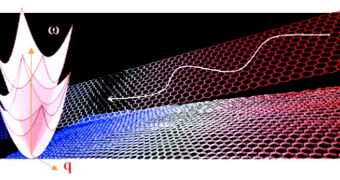When music fans talk about “hot sounds,” they have an entirely different thing in mind than physicists. The latter group is thinking about a host of acoustic phenomena that are effective in removing heat from various electronic devices. Now, experts at the Rice University have identified a process in which acoustic waves (sounds) travel across small, nanoscale ribbons of graphene, removing excess heat. This means that the industry proposed to deal with the construction if incredibly small electronics can now really take off, as heat was one of its main obstacles.
Expert Boris Yakobson, a physicist at Rice, and some of his graduate students have determined in a new theoretical model that graphene is perfectly capable of releasing thermal energy in waves. This material is an atom-thick carbon compound that exhibits amazing mechanical, physical and chemical properties. Together, this combination of traits makes it an ideal replacement for silicon in innovative electronic materials, but one of its main problems is that it generates a lot of heat. If the theoretical research holds in practice, then this issue may have just been eliminated.
The research team hypothesizes that, even though the carbon compound is capable of producing its own waves, the acoustic kind may work better for a simple reason – sounds are longer. This trait, coupled with the elasticity graphene exhibits, could promote a much more efficient heat dissipation process, the physicists say. Due to the reduced thickness of the material, and to the fact that it has no imperfections on its surface, sound waves can travel over large distances, without interfering with each other, or with various dimples and obstacles on the graphene sheet itself. “On this scale, graphene has promise for fundamental reasons. The speed of sound is the speed with which energy can be carried away, because heat is transported, essentially, through vibrations,” explains Yakobson.
The expert is part of a Rice program on materials science research that has recently been named the number 1 initiative of its kind in the world. He is also a professor of mechanical engineering, materials science, and chemistry at the university. Additional details of the new theoretical approach appeared in last week's online issue of the highly-regarded scientific journal Nano Letters. Funding for the investigation came from the Lockheed Martin Corp. and the Richard E. Smalley Institute for Nanoscale Science and Technology, at Rice.

 14 DAY TRIAL //
14 DAY TRIAL //